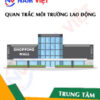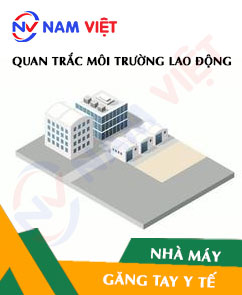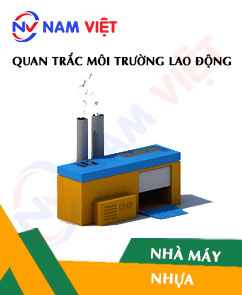Occupational environment monitoring in an office
99,000 ₫
Note: The above price is calculated for one sample, and the price may fluctuate depending on the area of the environment to be monitored and market movements. For more accurate pricing support, please refer to the price list or contact our consulting staff directly.
Monitoring the environment of an office is a session of collecting, analyzing, and evaluating factors at the workplace that may harm workers’ health.
Table of Contents
Toggle1. Overview of Offices
a. What is an Office?
A workplace office is an operational space used to perform administrative, managerial, and tasks related to documents, information, and communication within an organization, company, or enterprise. It is where employees and managers carry out their daily duties, including writing, reviewing, and processing documents, communicating via telephone and email, and performing various management activities.
Workplaces are typically equipped with necessary devices and tools such as computers, fax machines, photocopiers, telephones, projectors, desks, chairs, filing cabinets, and information management systems. Additionally, offices may have common areas such as meeting rooms, reception areas, break rooms, and restrooms.
Workplaces are designed and organized efficiently to optimize daily work effectiveness and convenience. They also facilitate communication and collaboration among members of the organization while providing a comfortable and professional working environment.

b. Common Tasks Performed in Offices
Common tasks performed in offices include:
- Information and document management: Processing and storing documents, records, reports, and related information. This includes data entry, organization, storage, and information security.
- Document processing: Drafting, editing, and formatting documents, reports, emails, and other materials. This may involve using word processing tools such as Microsoft Word or Google Docs.
- Communication and correspondence: Communicating via telephone, email, and internal messaging systems. This includes answering calls, sending and receiving emails, and conducting meetings or online seminars.
- Time and schedule management: Managing personal and colleagues’ schedules, arranging meetings, organizing tasks, and prioritizing work.
- Financial information processing: Monitoring and handling expenses, paying invoices, preparing simple financial reports, and performing basic financial management tasks.
- Office system management: Maintaining and updating office equipment, ensuring computer and network systems function properly, and managing office documents and supplies.
- Reception and record management: Welcoming and guiding visitors to the office, managing client or partner records, and providing necessary support.
- Management support: Performing tasks that assist management, including scheduling meetings, preparing documents, tracking tasks, and reporting.
- Communication information management: Maintaining directories, updating contact information of colleagues and clients, and ensuring communication information is kept up to date.

c. Types of Equipment Used in Offices
In offices, a variety of machinery and equipment are used to support work. Some common office equipment includes:
- Computers and printers: Computers are essential for performing word processing tasks, accessing the internet, managing data, and communication. Printers are used for printing and copying documents.
- Fax machines: Fax machines allow sending and receiving faxes directly over a telephone line. Although less commonly used today, they still appear in some offices.
- Photocopiers: Used to duplicate documents and texts. They can produce one or multiple copies at a time.
- Scanners: Used to convert paper documents into electronic format, storing images or texts on a computer.
- Projectors: Used to display content from computers or other devices onto a large screen or flat surface for presentations to an audience.
- Air conditioners: Used to regulate temperature and humidity in office spaces, creating a comfortable working environment for employees.
- Bookbinding machines: Used to bind books or staple documents together.
- Paper shredders: Used to compress or shred paper documents for storage and management purposes.
- Telephones and communication systems: Telephones are used for office communication, along with internal communication systems such as voicemail and online conferencing tools.

d. Occupational Diseases for Office Workers
Although working in an office is considered a safe environment, some occupational diseases may still occur. Common occupational diseases for office workers include:
- Movement-related disorders: Prolonged sitting and repetitive motions such as typing or using a mouse can lead to conditions like hand strain, spinal disorders, muscle inflammation, and wrist problems.
- Vision disorders: Extended use of computer screens can cause eye strain, discomfort, and reduced vision quality. This may result in nearsightedness or farsightedness.
- Spinal issues: Sitting for long periods in improper posture or without correct movement can stress the spine, causing back pain, neck pain, and related problems.
- Stress and mental strain: Work pressure, tight deadlines, and a stressful environment can cause mental stress and strain for office workers.
- Workspace-related health problems: Poor office conditions, including air pollution, imbalanced humidity, insufficient or excessive lighting, can cause health issues such as rhinitis, headaches, breathing difficulties, and other related symptoms.
- Infectious diseases: In confined workplaces with close contact among colleagues, there is a risk of transmitting infectious diseases such as flu, cold, or respiratory infections.

2. Overview of Workplace Environment Monitoring Services
a. What is Office Workplace Environment Monitoring?
Office workplace environment monitoring (or occupational environment measurement) is the activity of collecting, evaluating, and analyzing measurement indicators of workplace environmental factors in offices. The goal is to take timely measures to minimize environmental hazards to employees’ health and prevent occupational diseases. Workplace environment monitoring is mandatory for offices.
Monitoring plays a crucial role in caring for, protecting, and enhancing employees’ health, as the primary resource of a business and the direct contributor to profit is the workforce. Employees who are regularly exposed to risk factors and occupational hazards beyond permissible standards may suffer health impacts and develop occupational diseases.
REGISTER FOR WORKPLACE ENVIRONMENT MONITORING SERVICE
b. Nam Viet Workplace Environment Monitoring Program
Nam Viet’s workplace environment monitoring program is designed by monitoring engineers specializing in occupational safety and environmental protection. With the goal of ensuring employees’ health and safety, this program uses modern measurement methods to monitor air, water, and microclimate, physical factors, and dust in the workplace. This program is vital for ensuring a safe working environment and protecting employees’ health.
Additionally, Nam Viet’s monitoring program plays an important role in researching and developing new solutions to improve workplace environmental quality. With the dedication and professionalism of its monitoring experts, Nam Viet’s exclusive program represents a breakthrough in labor safety management and environmental protection in Vietnam.

c. Standardization in Workplace Measurement Procedures
Standardization in Nam Viet’s workplace measurement procedures is crucial for ensuring the accuracy and reliability of results. To guarantee precise and dependable measurements, the program adheres to standards and standardized procedures recognized by the Ho Chi Minh City Department of Health. This ensures that collected data can be reliably used to assess workplace environments and make informed decisions to improve them and safeguard employees’ health.
These standardized procedures also ensure that measurements are conducted by a team of highly qualified monitoring specialists with many years of experience, allowing managers and experts to trust Nam Viet’s results and make precise, valuable decisions for occupational health and environmental protection.
By implementing standardized measurement procedures, Nam Viet demonstrates its commitment to a safe work environment and employee health while actively contributing to the advancement of labor safety and environmental management in Vietnam.
d. Office Monitoring Report
Workplace environment monitoring results are prepared according to Form No. 04, Appendix III issued with Decree 44/2016/ND-CP and produced in two copies: one copy is sent to the workplace that signed the monitoring contract, and one copy is retained by the monitoring organization.
The retention period for monitoring results follows legal requirements and is stored indefinitely.

e. Frequency of Workplace Environment Monitoring According to the Law
According to Clause 2 of Article 18, Labor Safety and Hygiene Law 84/2015/QH13, employers must conduct workplace environment monitoring to assess harmful factors at least once a year.
f. Deadline for Submitting Workplace Environment Monitoring Reports According to the Law
The deadline for report submission is before December 31 each year. Enterprises in production facilities must submit their workplace environment monitoring reports to the local Department of Health where their main office or workplace is located.
When there are changes in technology, production processes, or when upgrading or renovating workplaces that may introduce new harmful factors affecting employees’ health, enterprises must update occupational hygiene records regarding harmful factors to be monitored.
g. Penalties for Violations of Workplace Environment Monitoring by Employers
According to Article 27 of Decree No. 12/2022/ND-CP dated January 17, 2022, on administrative penalties in the labor and social insurance sectors, and for Vietnamese workers working abroad under contracts:
- Clause 2: A fine of 2,000,000 – 5,000,000 VND for employers who fail to publicly disclose workplace environment monitoring results and hazardous factor evaluations to employees immediately after the monitoring and evaluation results are available.
- Clause 3: A fine of 20,000,000 – 40,000,000 VND for employers who do not conduct workplace environment monitoring to control health hazards as required by law.
- Clause 4: A fine of 40,000,000 – 60,000,000 VND for employers who collaborate with monitoring organizations to commit fraud in workplace environment monitoring but not to the extent of criminal liability.
3. Harmful Environmental Factors for Office Workers
The office working environment may contain factors that are harmful to employees’ health. The following are some potential environmental hazards:
- Air pollution: Office environments may have air pollution from sources such as inefficient air conditioning systems, inadequate ventilation, or emissions from electronic devices. This can cause symptoms like headaches, fatigue, eye irritation, and respiratory issues.
- Insufficient or excessive lighting: Working environments with insufficient or overly bright lighting can cause eye strain, difficulty concentrating, and discomfort while working.
- Imbalanced humidity: Too high or too low humidity in offices can cause problems for the skin, respiratory system, and overall health. Imbalanced humidity can also increase the risk of infectious diseases.
- Noise: Noise from electronic devices, air conditioning, printers, and loud conversations can cause discomfort, distraction, and stress.
- Uncomfortable working environment: Poor workspace design, uncomfortable chairs, inappropriate desks, and cramped spaces can lead to back pain, neck pain, shoulder pain, and other posture-related issues.
- Unclean environment: Poor hygiene in the office can create conditions for bacteria, viruses, and pathogens to grow and spread. This can lead to health problems such as respiratory and digestive infections.

REGISTER FOR WORKPLACE ENVIRONMENT MONITORING SERVICE
4. Measures to Improve Office Working Environment
To improve the office working environment and ensure employee health and comfort, the following measures can be implemented:
- Ensure good natural lighting: Open windows and blinds to utilize natural light, brightening and ventilating the workspace. This helps reduce eye strain and improve mood.
- Provide adequate artificial lighting: Use suitable lighting and LED lights that mimic natural light to ensure proper brightness in the office. Avoid harsh or glaring lights.
- Improve ventilation systems: Ensure effective ventilation to supply fresh air and remove polluted air from the office. Install air filters and perform regular maintenance to reduce air pollution.
- Maintain appropriate humidity: Use air conditioners or humidifiers to adjust office humidity. Humidity should be maintained at a comfortable level of around 40-60%.
- Control noise levels: Use soundproof panels, headphones, or create quiet spaces to reduce noise from devices and office activities.
- Create a comfortable workspace: Ensure desks and chairs are comfortable and adjustable for proper posture. Provide sufficient space for movement and rest.
- Maintain cleanliness and hygiene: Keep the office clean through regular cleaning, surface sanitization, and proper ventilation.
- Periodically conduct workplace environment monitoring in offices, collect and analyze harmful factors affecting employees, and implement adjustments to reduce hazards and prevent occupational diseases.
5. Benefits of Periodic Office Environment Monitoring
An Toan Nam Viet provides businesses with excellent benefits when using workplace environment monitoring services according to Decree 44/2016/ND-CP on managing and controlling harmful factors in working environments affecting employees.
- Businesses can proactively control harmful factors in offices or factories.
- Receive recommendations on measures to reduce harmful factors and improve the quality of the working environment.
- Indirectly protect human resources, the key factor in business development.
- Reduce the impact of occupational diseases on human health, thereby minimizing future treatment costs.
- Improved employee health leads to better product quality and consistent productivity.
- Comply with labor safety regulations and avoid legal risks.
- Enhance credibility and professionalism, elevating the business’s brand.
Nam Viet’s environmental monitoring service is a solution to minimize occupational disease risks, contributing to a clean and high-quality working environment.

6. Nationwide Workplace Environment Monitoring Center
Nam Viet Workplace Environment Monitoring Center is a professional unit specializing in monitoring and measuring workplace environmental quality throughout all provinces of Vietnam. With an experienced team of monitoring specialists, the center uses modern measuring equipment to ensure accuracy and reliability.
In addition to monitoring services, the center assists clients in planning, handling, and tracking workplace environmental issues. Following the motto “customer-centric,” the center prioritizes client satisfaction, meets all client needs, and provides the best solutions for businesses.
REGISTER FOR WORKPLACE ENVIRONMENT MONITORING SERVICE
With investment in technology, equipment, and personnel, Nam Viet’s monitoring center has become a reputable unit in workplace environment monitoring in Ho Chi Minh City, with objectives including:
- We always prioritize brand reputation and service quality.
- We provide clients with the best and most suitable solutions.
- Alongside a team of experienced Masters and Engineers committed to environmental protection and business benefits.
- By working with Nam Viet Environmental Monitoring, companies receive professional service from experts and the best cost advantages.
The workplace environment monitoring process at Nam Viet includes:
- Before monitoring, all machinery and equipment are calibrated according to legal regulations.
- Implement the complete monitoring process as committed to the Department of Health.
- Report monitoring results honestly to employers.
- If results indicate unsafe conditions, Nam Viet will provide solutions, and the enterprise will implement:
- Measures to improve working conditions, minimize harmful factor impacts, and prevent occupational diseases.
- Health check-ups to detect occupational and work-related diseases early for employees in unsafe environments.
- Provide in-kind benefits to employees according to labor laws.

7. Workplace Environment Monitoring Service Price List
To help businesses perform workplace environment monitoring professionally and effectively, Nam Viet provides clients with a quality and reasonably priced service price list.
- Our price list provides detailed information on the costs of monitoring services we offer, including transportation, measurement, analysis, and reporting. Clients can trust the accuracy and reliability of our monitoring reports.
- We commit to offering the most competitive and reasonable prices in the market and are always ready to answer questions about monitoring services quickly and professionally.
- With Nam Viet’s price list, clients can easily choose service packages that meet their needs. We are committed to delivering the highest satisfaction with professional service quality.
No comments yet












Review Occupational environment monitoring in an office
There are no reviews yet.